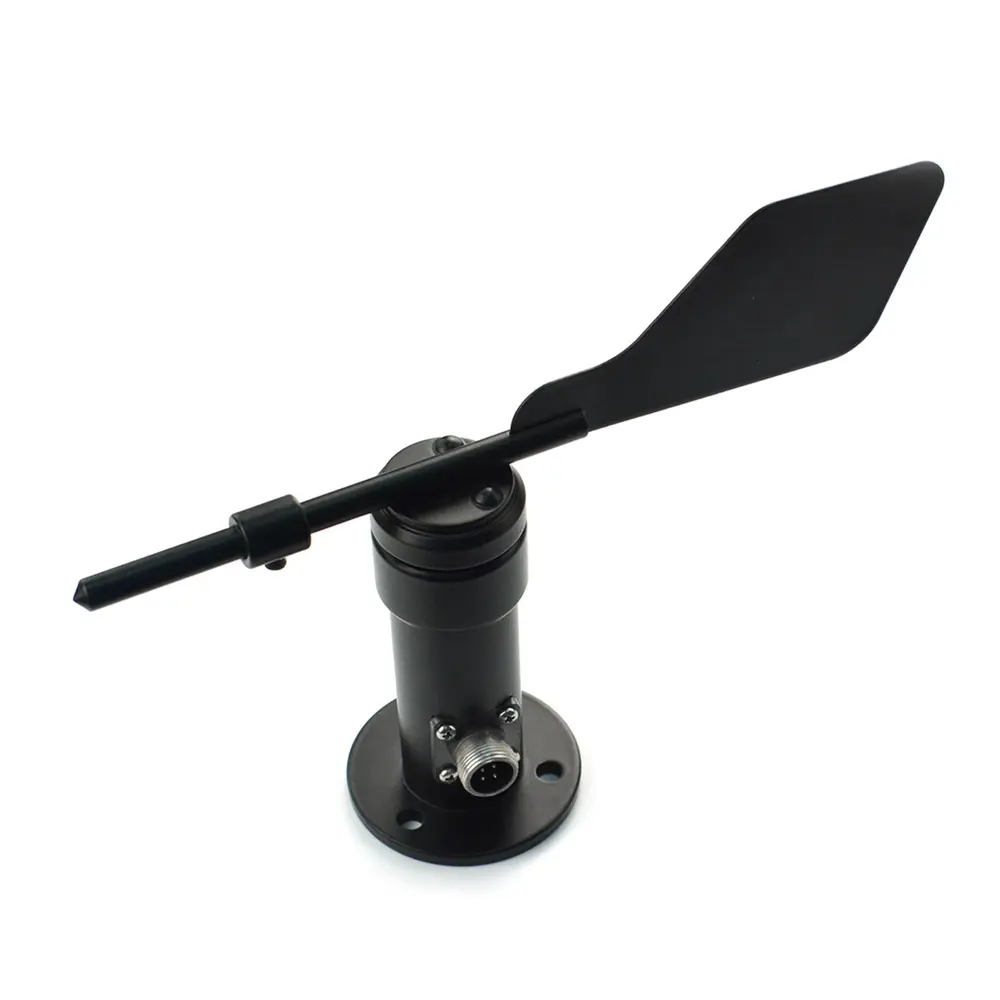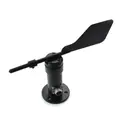DFRobot RS485 Wind Vane Direction Sensor

Description
The wind direction sensor, or wind vane, is a precise instrument utilized for measuring horizontal wind direction. It boasts a hall sensor embedded within its structure. Constructed from a durable aluminum alloy, the sensor undergoes a special precision die-casting process, resulting in minimal dimensional tolerance and impressive surface accuracy. Its internal circuit is fortified to deliver superior strength, weather resistance, anti-corrosion properties, and waterproofing.
The device features a corrosion-resistant military-grade plug for its cable connector, ensuring an extended service life. At the heart of its functionality is a low-inertia wind direction sensor. This component is adept at detecting changes in wind direction with agility. As the wind shifts, the tail wing pivots, driving the axle magnet through the shaft to yield precise wind direction data.
Capable of identifying up to 16 natural wind directions, this sensor demonstrates exceptional cost performance and is applicable across diverse fields, including meteorology, marine environments, environmental monitoring, airports, ports, laboratories, industrial contexts, agriculture, and transportation sectors.
The sensor operates through the interaction between the wind and the vane. The nose of the vane aligns with the wind direction as the wind influences its flat surface, causing it to rotate appropriately. This movement is translated into an electrical signal by a potentiometer or magnetic sensor attached to the vane, and further processed to ascertain the wind direction.
Properties
| Brand | DFRobot |
| Model | SEN0482 |
| More info | RS485 Wind Direction Sensor/Transmitter V2 Wiki - DFRobot |
Customer questions
Customer Reviews
- In stock DFRobot DFPlayer - A Mini MP3 Player For Arduino € 7,50 View product
- In stock DFRobot Gravity: MOSFET Power Controller € 5,- View product
- In stock DFRobot DF9GMS 360 Degree Micro Servo (1.6Kg) € 5,- View product
- In stock DFRobot Gravity: 8-Digital LED Segment Display Module (Green) € 7,50 View product
- In stock DFRobot Gravity: 8-Digital LED Segment Display Module (Red) € 7,50 View product
- In stock DFRobot Gravity: Analog Turbidity Sensor For Arduino € 12,25 View product
- In stock DFRobot Gravity Photoelectric Water / Liquid Level Sensor For Arduino € 8,75 View product
- In stock DFRobot DFRduino UNO R3 - Arduino Compatible € 16,- View product
- In stock DFRobot Gravity: Waterproof DS18B20 Sensor Kit € 9,40 View product
- In stock DFRobot 8x8 Matrix ToF 3D Distance Sensor (I2C&UART, 3.5m Range, 60° FOV) € 27,25 View product
- In stock DFRobot DFRduino Mega2560 (Arduino Mega 2560 R3 Compatible) € 28,50 View product
- In stock DFRobot Fermion: DFPlayer Pro - A mini MP3 Player with On-board 128MB Storage (Breakout) € 11,- View product
- In stock DFRobot FireBeetle ESP8266 IoT Microcontroller (Supports Wi-Fi) € 9,25 View product
- In stock DFRobot Gravity: Digital 360° Tilt Sensor for Arduino € 3,60 View product
- Reduced In stock -65 % DFRobot Gravity: Gesture & Touch Sensor € 13,95 € 4,85 View product
Recently viewed items
- In stock DFRobot RS485 Wind Vane Direction Sensor € 55,75 View product
- DFRobot LED Voltage Meter (Red) € 2,- View product
- DFRobot Extension Cable For Raspberry Pi Camera € 2,50 View product
- DFRobot Straight/Cross Screwdriver € 3,75 View product
- DFRobot Wireless Charging Module 5V/1A € 8,75 View product
- DFRobot Raspberry Pi Pico 2 € 6,25 View product
- New Waveshare 2D Codes Scanner Module (C), Supports High Accuracy Barcode Scanning, Barcode/QR code Reader € 55,75 View product
- New Waveshare 7.5inch e-Paper Raw Panel Case € 5,75 View product
- New Waveshare Raspberry Pi Camera Cable FFC 60cm € 2,50 View product










